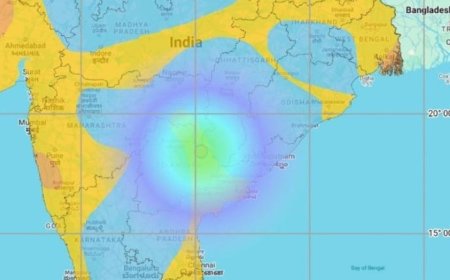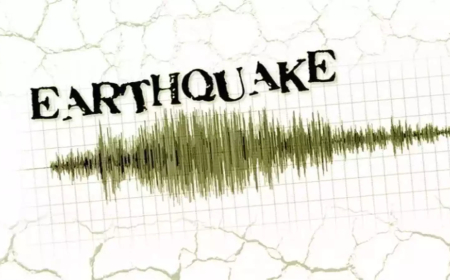US Shifts Position on India-Pakistan Tensions: From "Not Our Concern" to "Extended Talks"
The United States has altered its stance on the ongoing India-Pakistan tensions, moving from initial indifference to encouraging prolonged discussions between the two nations. This article explores the evolution of the US's position, the reasons behind the shift, and what it means for the future of South Asian diplomacy.

Introduction: A Shift in US Policy on India-Pakistan Relations
The United States’ position on the ongoing tensions between India and Pakistan has undergone a significant transformation in recent months. Initially, the US had shown little interest in becoming involved in the South Asian conflict, often opting for a "not our business" approach. However, recent developments have led to a shift in Washington's perspective, as it now encourages longer and more in-depth diplomatic conversations between the two nuclear-armed neighbors.
In this article, we’ll explore the evolution of the US's stance on India-Pakistan tensions, the factors that have contributed to this change, and the potential consequences of the new approach for South Asian peace and stability.
1. The Early Days: "None of Our Business" - The US’s Initial Indifference
For much of the history of India-Pakistan relations, the United States adopted a relatively neutral stance, often claiming that the tensions between the two countries were not of direct concern to American interests. While the US did acknowledge the importance of regional stability, it rarely intervened directly, choosing instead to focus on broader geopolitical issues such as the war on terror, relations with China, and the situation in Afghanistan.
During critical moments in the India-Pakistan relationship, particularly during military skirmishes and diplomatic standoffs, the US would often call for restraint but stopped short of taking any concrete steps to mediate or intervene. This approach was rooted in a belief that both India and Pakistan were sovereign nations capable of managing their own affairs. Additionally, the US had strategic partnerships with both countries—India as a rising power and economic partner, and Pakistan as a key ally in the fight against terrorism in the region.
However, despite these alliances, the US’s response was typically passive, with little effort to actively influence or ease the tensions between India and Pakistan. The sentiment often echoed was, “This is not our business.”
2. The Shift Begins: Growing Concern Over Escalation
The situation began to change as tensions between India and Pakistan escalated to new heights in the last few years. The 2019 Pulwama attack and the subsequent airstrikes by both countries marked a critical turning point in the region. The world watched as two nuclear-armed nations stood on the brink of war, and the risks of conflict spilling over into a larger regional crisis became increasingly clear.
The United States, traditionally preoccupied with its interests in the Middle East and East Asia, began to realize that the Indo-Pakistani conflict was no longer an isolated issue. The possibility of nuclear escalation, terrorism, and the destabilizing effects on global trade and security made it an issue that directly impacted US interests.
This realization triggered a shift in Washington’s stance. Rather than sitting on the sidelines, the US began calling for diplomatic dialogue and de-escalation between the two nations, signaling a departure from its previous position of indifference.
3. The US's New Stance: "A Long Night of Talks" and Active Engagement
As the US started to see the growing threat of violence between India and Pakistan, it began to take a more active role in encouraging dialogue. This shift was symbolized by the remarks from US officials encouraging "long nights of talks" between the Indian and Pakistani governments. Washington emphasized the importance of sustained diplomatic efforts to resolve the issues between the two nations, especially given the potential for regional instability.
This change in policy reflects a broader shift in the US's foreign policy approach. Washington’s recognition of the importance of India and Pakistan in regional and global security, along with the increased understanding of the risks posed by continued tensions, has led to a more hands-on approach in dealing with the India-Pakistan relationship.
4. Why the Change in US Policy?
Several factors have contributed to the US’s evolving stance on the India-Pakistan tensions:
Geopolitical Realities
The US’s growing geopolitical concerns in Asia have made it increasingly aware of the importance of South Asia in global security. With China’s rise as a dominant global power, the US sees India as a crucial partner in counterbalancing Beijing’s influence in the region. At the same time, Pakistan's close ties with China have complicated the situation, as the US needs to ensure that its alliances with both India and Pakistan remain stable.
Nuclear Threats and Regional Stability
Both India and Pakistan possess nuclear weapons, and the risk of an accidental or deliberate escalation leading to a nuclear conflict has made the situation increasingly dangerous. With global security at stake, the US has come to understand that fostering peace and reducing tensions in the region is in its best interest.
International Pressure and Mediation
The US is also responding to increasing international pressure to play a more active role in mediating the India-Pakistan conflict. The United Nations and other global powers have called for Washington to step in, recognizing the potential for regional instability that could have far-reaching consequences.
Terrorism and Extremist Threats
Both India and Pakistan have been affected by terrorism and extremist activities, and the US has a vested interest in reducing these threats. By encouraging dialogue, the US hopes to create an environment where both countries can work together to combat terrorism and maintain regional peace.
5. US Involvement in India-Pakistan Peace Talks: What Does It Mean?
The US’s growing involvement in the India-Pakistan tensions could have several important consequences:
Facilitating Dialogue
With the US playing a more active role, there is potential for more structured and effective peace talks between India and Pakistan. While both countries have historically been hesitant to engage in direct dialogue, the US’s involvement could help create an atmosphere where both sides are willing to negotiate.
Promoting Confidence-Building Measures
The US can also work towards fostering confidence-building measures between India and Pakistan, helping to ease suspicions and build trust. This could involve addressing key issues such as Kashmir, terrorism, and military skirmishes along the border.
Stabilizing the Region
By encouraging dialogue and diplomatic efforts, the US can contribute to stabilizing the region. This would reduce the likelihood of conflict and contribute to broader peace and security in South Asia.
6. The Path Ahead: Challenges and Opportunities
While the US’s change in stance is a positive step toward addressing the tensions between India and Pakistan, it is important to recognize that the path ahead remains challenging. Both India and Pakistan have deep-rooted issues that are not easily resolved, and there are significant obstacles to achieving lasting peace.
However, the US’s active involvement in promoting dialogue provides an opportunity for both countries to move toward a more peaceful and stable future. Through continued engagement, diplomacy, and international cooperation, there is hope that tensions can be reduced and long-term solutions can be found.
Conclusion: A Critical Moment for US Foreign Policy
The United States’ shift from a neutral stance to encouraging extended diplomatic talks between India and Pakistan marks a significant moment in international relations. With the potential for conflict high, the US’s active involvement could be crucial in preventing escalation and ensuring that peace prevails in South Asia.
As the situation unfolds, the world will be watching to see how the US, along with India, Pakistan, and other global powers, works toward a resolution. The stakes are high, and the need for cooperation and dialogue has never been more pressing.
This article provides an engaging overview of the US's changing stance on India-Pakistan tensions, offering readers a deeper understanding of the shifting dynamics and their potential implications for regional stability and international diplomacy.
What's Your Reaction?





























































